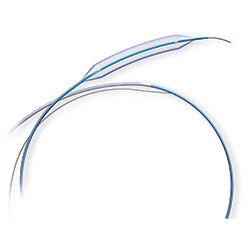
Rapid exchange system ideal for vascular arterial access and dilatation.



Data on file at Abbott.
MAT-2114530 v2.0

The Viatrac™ 14 Plus Peripheral Dilatation Catheter is intended:
None known for percutaneous transluminal angioplasty (PTA).
The Viatrac™ 14 Plus Peripheral Dilatation Catheter is not intended for use in the coronary arteries.
This device is intended for one-time use only. DO NOT resterilize and / or reuse it, as this can compromise device performance and increase the risk of cross contamination due to inappropriate reprocessing.
To reduce the potential for vessel damage, the inflated diameter of the balloon should approximate the diameter of the vessel just proximal and distal to the stenosis.
When the catheter is exposed to the vascular system, it should be manipulated while under high-quality fluoroscopic observation. Do not advance or retract the catheter unless the balloon is fully deflated under vacuum. If resistance is met during manipulation, determine the cause of the resistance before proceeding.
Balloon pressure should not exceed the rated burst pressure (RBP). Refer to the product label for device specific information. The RBP is based on results of in vitro testing. At least 99.9% of the balloons (with a 95% confidence) will not burst at or below their RBP. Use of a pressure monitoring device is recommended to prevent over-pressurization.
Use only the recommended balloon inflation medium. Never use air or any gaseous medium to inflate the balloon.
Use the catheter prior to the “Use by” date specified on the package.
Do not use, or attempt to straighten, a catheter if the shaft has become bent or kinked, as this may result in the shaft breaking. Instead, prepare a new catheter.
A thorough understanding of the principles, clinical applications, and risks associated with percutaneous transluminal angioplasty (PTA) is necessary before using this product.
Any use for procedures other than those indicated in these instructions is not recommended.
This device is not recommended for use in lesions that may require inflation higher than those recommended for this catheter.
Do not use if package is open or damaged.
Prior to angioplasty, the catheter should be examined to verify functionality and ensure that its size and shape are suitable for the specific procedure for which it is to be used.
During the procedure, appropriate anticoagulant therapy must be provided to the patient as needed. Anticoagulant therapy should be continued for a period of time to be determined by the physician after the procedure.
Shaft diameter differences should be taken into consideration when opening and tightening the hemostatic valve and upon withdrawal of the catheter.
It is important that the hemostatic valve (if used) is closed tightly enough to prevent blood leakage around the catheter shaft, yet not so tightly that it restricts the flow of contrast into and out of the balloon or restricts guide wire movement.
Possible adverse events include but are not limited to:
MAT-2114532 v2.0
Stay Connected